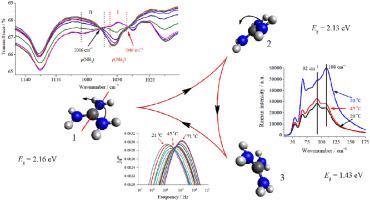Materials Chemistry and Physics ( IF 4.6 ) Pub Date : 2021-09-13 , DOI: 10.1016/j.matchemphys.2021.125240 S. Dimitrovska-Lazova 1 , M. Bukleski 1 , P. Tzvetkov 2 , M. Pecovska-Gjorgjevich 3 , D. Kovacheva 2 , S. Aleksovska 1

|
Hybrid organic-inorganic perovskites (HOIPs) have attracted considerable attention, especially organometal trihalide perovskite, as promising materials for high-efficient solar cells. An interesting organic cation that can be incorporated in perovskite structure is the guanidinium (GUA) cation. Therefore, a number of investigations have been performed on the structure, stability and phase transitions of GUAPbI3. Herein, a study of the isostructural phase transition that is for the first time detected in GUPbI3, as well as some properties of the phase related to this transition, are presented. The existence of a new phase was deduced by the appearance of the temperature dependent isosbestic point at 47–48 °C in the infrared spectra, and the results obtained by the Raman spectroscopy. According to the powder X-ray diffraction (PXRD) patterns analysis, it was concluded that this phase transition is not accompanied by a change in the space group of the perovskite structure making it an isostructural one, and consequently, no additional peak at this temperature on differential thermal analysis (DTA) was detected. In order to relate the existence of this phase to the application of GUAPbI3 in solar cells, electrical measurements were undertaken from 24 to 71 °C. Thin films of GUAPbI3 on glass substrate were also prepared. The Ultra-violet and visible (UV/Vis) spectra of the corresponding phases were recorded and the band gaps were calculated.
中文翻译:

C(NH2)3PbI3 中等结构相变的机制作为理解新相性质的指南
杂化有机-无机钙钛矿(HOIPs)引起了广泛关注,尤其是有机金属三卤化物钙钛矿,作为高效太阳能电池的有前途的材料。可以结合到钙钛矿结构中的一种有趣的有机阳离子是胍 (GUA) 阳离子。因此,已经对GUAPbI 3的结构、稳定性和相变进行了大量研究。在此,首次在 GUPbI 3 中检测到的同构相变的研究,以及与此转变相关的相的一些属性。新相的存在是通过红外光谱中 47-48°C 温度相关等吸收点的出现以及拉曼光谱获得的结果来推断的。根据粉末 X 射线衍射 (PXRD) 图案分析,得出的结论是,这种相变不伴随钙钛矿结构空间群的变化,使其成为同构结构,因此在该温度下没有额外的峰差热分析(DTA)检测。为了将这一阶段的存在与 GUAPbI 3在太阳能电池中的应用联系起来,在 24 到 71 °C 之间进行了电测量。GUAPbI 3薄膜在玻璃基板上也制备了。记录相应相的紫外和可见光 (UV/Vis) 光谱并计算带隙。


























 京公网安备 11010802027423号
京公网安备 11010802027423号